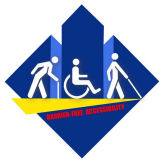Barrier Free Access – Designing for the Visually Impaired
With a rising elderly population in the world in countries such as Singapore, Australia, New Zealand, Japan, South Korea, China, Thailand, Malaysia, Indonesia, Brunei etc, the importance of designing barrier free access with vision impairment in mind becomes more important.

Vision impaired people could be classified into those who do not have sight at all and those who have partial sight.
A significant proportion of the elderly have partial sight. The desired result would be an environment in which people with vision impairments can travel independently and safely.
Many people who are blind sometimes have some small amount of residual vision, and all people with vision impairment will use whatever vision they have, together with other aids, to find their way around. Some may choose to travel with a sighted guide; others will choose to travel independently. For those who choose to travel independently, continual and extensive use will have to be made of physical cues and other sensory cues.
Physical elements such as walls and curbs can act as cues to assist independent travel. For example, a person using a cane might be able to follow a wall line from one point to another. Physical cues can be identified either by use of a cane, or under foot.
People with low vision also rely on information obtained by other ways including touch, sound and smell. Information can also be in the form of tactile or audible information.
Tactile ground surface indicators are one form of tactile indicator. In essence they are a physical cue, which is detectable either under foot or by the use of a cane. Tactile ground surface can serve as warning or directional indicators.
Warning indicators can warn of a hazard e.g. near the edge of a train platform, or steps, pedestrian crossing etc. Directional indicators are used to direct the user from one point to another. For example, a directional treatment might be used in an open pedestrian plaza to indicate a clear path of travel, or provide assistance to locate amenities such as restrooms etc.
